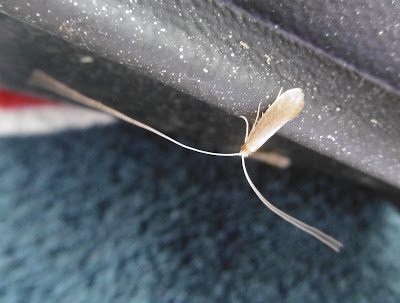I am probably addicted to novelty, as someone who made their living from the news for forty years. So it is obliging of the moths to provide me, almost every day, with newcomers to my eggbox hotel.
They are seldom completely new these days, after ten years of running my light trap in Leeds and Oxfordshire, but the summer brings a scarcely interrupted flow of debuts for the year. This morning, for example, there are four of them.
My favourite is the Beautiful Hook-tip shown in the first photograph, one of nine UK moths accorded the official title of 'Beautiful' in their name from the Beautiful Chestnut to the Beautiful Yellow Underwing. That list is a speck more exclusive than it looks because it includes the Beautiful Utetheisa, an American moth recorded in the UK only once, on Skokholm Island off Pembrokeshire at the end of July 1948. It is so rare that it doesn't even have its picture in t
he Moth Bible, which is a shame as you can see if you Google it.
The Mottled Beauty, above is a beautifully-patterned moth, but to call it the Beautifully Patterned Mottled Beauty would be going a bit far. The notion reminds me of my predecessor as Northern Editor of The Guardian, Harry Whewell, who was rung up to be told that "...the Midland Hotel will in future be known as the Forte Crest (or some such) Midland Hotel." "Not by me, it won't," he replied.
The Poplar Grey, next in my newcomers' list, stands out in the moth trap as one of a 'silvery' colourway of arrivals, which also includes the Dark and Grey Daggers and the Miller. This one was sleeping on the black plastic bowl of the trap which is a nightmare background for digital photography - which really does turn black white, or at least a dirty grey, in its heroic attempts to gather every bit of light it can - but I managed to entice it on to a scrap of eggbox for a photo shoot.

Here's an example of what I mean about digital black magic, above. The background to my fourth newcomer, a sweet Single-dotted Wave, is black to the human eye. But not to Panasonic's Lumix. These little moths are almost impossible to disturb with them fluttering off. It seems to be an axiom of moths that the slenderer their body, the lighter they sleep. But luckily there were three in the trap this morning and one of them, below, had chosen a more helpful place to doze. Why is a moth which such a spattering of dots called the Singled-dotted? No one has ever enlightened me about that.
The next moth shown, a slightly lifeworn Common White Wave (I think), may also be new for this year. I'm not sure offhand, and I need to get going on the morning tea so will scroll back through the records later. Isn't it graceful, though? A Laura Ashley moth, as is the Light Emerald which follows.
I had to include the emerald, just because I like it, which also applies to the Buff Tip, below. Both pictures also include exciting glimpses of my knee, and in the case of the Buff Tip, the distant 'black' bowl of the trap whose effect on digital cameras I have moaned about above.
Finally, two pieces of homework: one of the carpet moths pretending to be a butterfly, and a pug of some kind. Moth people get very grumpy about pugs, which almost all look annoyingly the same, but you can't blame the poor things for trying to help. This one's posture is typical - spreading itself out like a police search suspect. Sadly, it doesn't assist my ID efforts.






















































